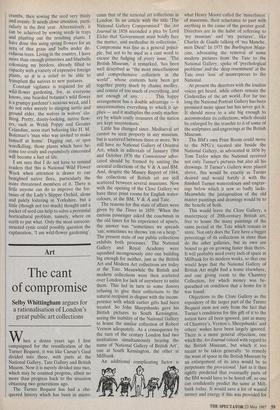Gardens
Switching to flora
Ursula Edwards
There are two aspects to making a garden, on that we are all agreed. One is the cultivation of plants, the other their disposition. Opinions differ about the rela- tive difficulties of each. At present, it is fashionable to maintain that any damn fool can grow plants but that it is placing them happily within a coherent scheme which Arranged by Nature — wild flowers by a roadside.
takes the skill. Up to a point, Lord Copper. Certainly we can all attain a degree of competence in practical matters if we are truly interested, but there are some people who will never design a garden to their (or anyone else's) satisfac- tion. It is just one of those things, like not being good at games. The thought of placing plants together which will harmo- nise, or agreeably contrast, both in flower and out of it, at every season of the year, can be terrifying. It is • easy to be borne down under the weight of possibilities. There are people who would love to be able to look through half-closed eyes and murmur: 'the dianthus foliage will set off the dicentra flowers to perfection in the pink border' but they cannot. They are often the most practical and hard-working gardeners who would be perfectly content if they did not feel others rather despised them for their lack of artistry. If the truth is told the group I describe encompasses all but a fortunate few.
Help is however at hand, from a rather unexpected quarter. The sincere, if often impotent, distress we feel at the way numerous wild flowers have been pushed towards extinction has focused the atten- tion of conservationists on an important (forgive the jargon) land resource: the million acres which make up the nation's gardens.
Growing wild flowers in gardens can harness the practical capabilities of keen gardeners (for it is not for the idle) without the need for them to make ticklish deci- sions about colour combinations, or even where to put paths or borders; at the very least it can solve the problem in one intractable spot, where the plants required for a particular colour scheme resolutely refuse to prosper. The results of a random sowing of a packet of mixed seed can be startlingly pretty, even in a very restricted space, and, what is more, wildlife is un- doubtedly encouraged by the presence of native plants. (There is much innocent enjoyment to be had testing friends on their knowledge of the food plants visited by hawk-moths.) Wild flowers positively do not thrive on rich ground, where they are pushed out by aggressive grasses, so that this kind of gardening is suitable for all those forced to cultivate a long-abandoned garden or the cement-mixer site next to their new house. For the city gardener, a stretch of 'meadow' beyond the French windows would look no more incongruous than the country house parterre in minia- ture which is frequently proposed. The wild-flower mixtures for conditions as various as 'woodland', 'hedgerow', `meadow', 'cornfield' and 'pond-margin' can be bought from seedsmen by mail order or even in garden centres; the seed is gathered from plants grown in nurseries so that there is no threat to the existing native flora. A meadow mixture might well con- tain seed of 20 species of wild flowers, such as ragged robin, bird's foot trefoil, cowslip and ox-eye daisy, together with several fine grasses in small quantities.
The `mini-meadow', as it is rather inele- gantly called, is not made by scattering seed over an overgrown lawn and hoping that Nature will take its course. It is made with a deal of hard work, first by weedkill- ing the grass with the non-residual herbi- cide glyphosate, then rotovating or digging the soil, treading the surface down firmly, raking it level and into a 'filth' of fine soil crumbs, then sowing the seed very thinly and evenly. It needs close attention, parti- cularly in the first year. Alternatively, it can be achieved by sowing seeds in trays and planting out the resulting plants. I have done this using spring flowers for an area of thin grass and bulbs under de- ciduous trees. Living in the country, I have more than enough primroses and bluebells colonising my borders, already filled to capacity with a variety of expensive foreign plants, so it is a relief to be able to transplant the natives to new pastures.
Constant vigilance is required for all wild-flower gardening, for, as everyone knows, one bearded botanist's wild flower is a grumpy gardener's noxious weed, and I do not refer merely to stinging nettle and ground elder, the wolves in wolves' clo- thing. Pretty, dainty-looking, native flow- ers, such as Welsh Poppy and Greater Celandine, soon start behaving like H. M. Bateman's 'man who was invited to make himself at home'. Digging out, or spot weedkilling, those plants which have be- come too cosily and expansively ensconced will become a fact of life.
I am sure that I do not have to remind readers that this is National Wild Flower Week when attention is drawn to our benighted native flora, particularly the more threatened members of it. There is little anyone can do to improve the for- tunes of the Lady's Slipper Orchid, alone and palely loitering in Yorkshire, but a little (though not too much) thought and a packet of seed can help to solve a perennial horticultural problem, namely, where on earth to put what. Only the most unrecon- structed cynic could possibly question the explanation, 'I am wild-flower gardening'.










































































 Previous page
Previous page